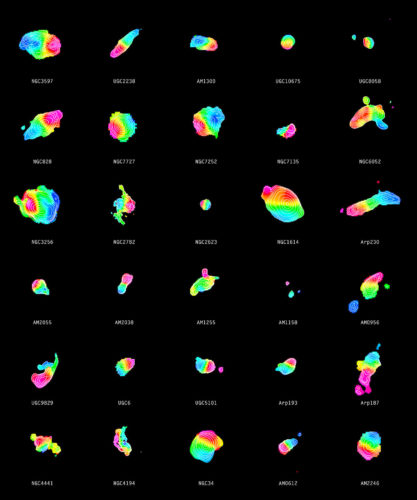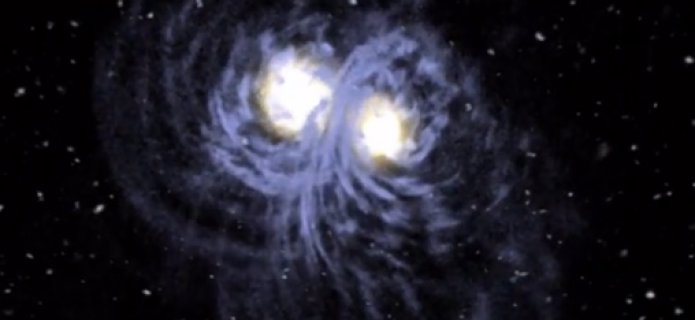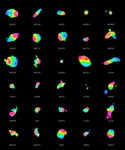Violent Origins of Pancake Galaxies Probed by ALMA
17 September, 2014 / Read time: 6 minutes
New observations explain why Milky Way-like galaxies are so common in the Universe
For decades scientists have believed that galaxy mergers usually result in the formation of elliptical galaxies. Now, for the the first time, researchers using ALMA and a host of other radio telescopes have found direct evidence that merging galaxies can instead form pancake galaxies, and that this outcome is in fact quite common. This surprising result could explain why there are so many spiral galaxies like the Milky Way in the Universe.
An international research group led by Junko Ueda, a Japan Society for the Promotion of Science postdoctoral fellow, has made surprising observations, with ALMA and other radio telescopes, that most galaxy collisions in the nearby Universe (within 40–600 million light-years from Earth) result in so-called disc galaxies. These galaxies, including spiral galaxies like the Milky Way and lenticular galaxies, are defined by pancake-shaped regions of dust and gas, and are distinct from the category of elliptical galaxies.

Distribution of gas in merging galaxies observed by radio telescopes.Contours indicate the radio intensity emitted from CO gas. The colour shows the motion of gas. The red color indicates gas is moving away from us while the blue colour is coming closer to us. The gradation from red to blue means that gas is rotating in a disc-like manner around the centre of the galaxy. | Credit: ALMA (ESO/NAOJ/NRAO)/SMA/CARMA/IRAM/J. Ueda et al.
It has, for some time, been widely accepted that merging disc galaxies would eventually form an elliptically shaped galaxy. During these violent interactions the galaxies do not only gain mass as they merge or cannibalise each-other, but they are also changing their shape throughout cosmic time, and therefore changing type along the way.
Computer simulations from the 1970s predicted that mergers between two comparable disc galaxies would result in an elliptical galaxy. The simulations predict that most galaxies today are elliptical, clashing with observations that over 70% of galaxies are in fact disc galaxies. However, more recent simulations have suggested that collisions could also form disc galaxies.
To identify the final shapes of galaxies after mergers observationally, the group studied the distribution of gas in 37 galaxies that are in their final stages of merging. The Atacama Large Millimeter/sub-millimeter Array (ALMA) and several other radio telescopes [1] were used to observe emission from carbon monoxide (CO), an indicator of molecular gas.
The team’s research is the largest study of molecular gas in galaxies to date and provides unique insight into how the Milky Way might have formed. Their study revealed that almost all of the mergers show pancake-shaped areas of molecular gas, and hence are disc galaxies in the making. Ueda explains that "for the first time there is observational evidence for merging galaxies resulting in disc galaxies, not elliptical galaxies. This is a large and unexpected step towards understanding the mystery of the birth of disc galaxies".
Nonetheless, there is a lot more to discover, as Dr. Ueda further explains, "We have to start focusing on the formation of stars in these gas discs. Furthermore, we need to look farther out in the more distant Universe. We know that the majority of galaxies in the more distant Universe also have discs. We however do not yet know whether galaxy mergers are also responsible for these, or whether they are formed by cold gas gradually falling into the galaxy. Maybe we have found a general mechanism that applies throughout the history of the Universe".
Notes
[1] The data were obtained by ALMA, the Combined Array for Research in Millimeter-wave Astronomy: a millimeter array consisting of 23 parabola antennas in California, the Submillimeter Array a submillimeter array consisting of eight parabola antennas in Mauna Kea, Hawaii, and the Plateau de Bure Interferometer, the NAOJ Nobeyama Radio Observatory 45m radio telescope, USA’s National Radio Astronomy Observatory 12m telescope, USA's Five College Radio Astronomy Observatory 14m telescope, IRAM’s 30m telescope, and the Swedish-ESO Submillimeter Telescope as a supplement.
More Information
The Atacama Large Millimeter/submillimeter Array (ALMA), an international astronomy facility, is a partnership of the European Organisation for Astronomical Research in the Southern Hemisphere (ESO), the U.S. National Science Foundation (NSF) and the National Institutes of Natural Sciences (NINS) of Japan in cooperation with the Republic of Chile. ALMA is funded by ESO on behalf of its Member States, by NSF in cooperation with the National Research Council of Canada (NRC) and the Ministry of Science and Technology (MOST) in Taiwan and by NINS in cooperation with the Academia Sinica (AS) in Taiwan and the Korea Astronomy and Space Science Institute (KASI).
ALMA construction and operations are led by ESO on behalf of its Member States; by the National Radio Astronomy Observatory (NRAO), managed by Associated Universities, Inc. (AUI), on behalf of North America; and by the National Astronomical Observatory of Japan (NAOJ) on behalf of East Asia. The Joint ALMA Observatory (JAO) provides the unified leadership and management of the construction, commissioning and operation of ALMA.
These observation results were published in The Astrophysical Journal Supplement (August 2014) as Ueda et al. "Cold Molecular Gas in Merger Remnants. I. Formation of Molecular Gas Discs". The team is composed of Junko Ueda (JSPS postdoctoral fellow/National Astronomical Observatory of Japan [NAOJ]), Daisuke Iono (NAOJ/The Graduate University for Advanced Studies [SOKENDAI]), Min S. Yun (The University of Massachusetts), Alison F. Crocker (The University of Toledo), Desika Narayanan (Haverford College), Shinya Komugi (Kogakuin University/ NAOJ), Daniel Espada (NAOJ/SOKENDAI/Joint ALMA Observatory), Bunyo Hatsukade (NAOJ), Hiroyuki Kaneko (University of Tsukuba), Yoichi Tamura (The University of Tokyo), David J. Wilner (Harvard-Smithsonian Center for Astrophysics), Ryohei Kawabe (NAOJ/ SOKENDAI/The University of Tokyo) and Hsi-An Pan (Hokkaido University/SOKENDAI/NAOJ)
Links
Link to Research Paper on Astro-Ph
Contacts
Junko Ueda
JSPS postdoctoral fellow/NAOJ
Tel: 0422-34-3117
Email:[email protected]
Nicolas Lira T
Education and Public Outreach Assistant
Joint ALMA Observatory
Santiago, Chile
Tel: +56 2 467 6519
Cell: +56 9 94457726
Email: [email protected]
Masaaki Hiramatsu
Education and Public Outreach Officer, NAOJ Chile
Observatory Tokyo, Japan
Tel: +81 422 34 3630
E-mail: [email protected]
Richard Hook
Public Information Officer, ESO
Garching bei München, Germany
Tel: +49 89 3200 6655
Cell: +49 151 1537 3591
Email: [email protected]
Charles E. Blue
Public Information Officer
National Radio Astronomy Observatory
Charlottesville, Virginia, USA
Tel: +1 434 296 0314
Cell: +1 434.242.9559
E-mail: [email protected]

